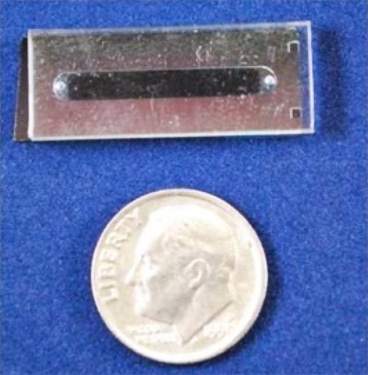Engineers have developed a device that can detect single cancer cells in a blood sample.
That’s right, even a tiny amount of disease may not have a safe place to hide in the human body anymore.
According to the MIT News Office, a Harvard bioengineer and an MIT aeronautical engineer have created a new method that can identify single cancer cells in a blood sample. This astonishing breakthrough could potentially allow doctors to determine whether cancer has spread from its original site, and it would allow them to do it quickly.
This microfluidic device is described in the March 17 online edition of the academic journal Small (pay wall); it’s roughly the size of a dime, and it could also detect viruses like HIV. In the future it could be developed into cheap tests for doctors to use in poorer countries where pricey diagnostic equipment is hard to acquire, says Mehmet Toner, professor of biomedical engineering at Harvard Medical School and a member of the Harvard-MIT Division of Health Sciences and Technology.

Toner constructed a different version of the device four years ago. In that first version, blood taken from a patient streams past tens of thousands of minuscule silicon posts layered with antibodies that stick to tumor cells. Any cancer cells that touch the posts become ensnared. However, some cells might never bump into the posts at all.
Toner believed that if the posts were absorbent instead of solid, cells could flow right through them, increasing the chance that they would stick. To accomplish that, he solicited the help of Brian Wardle, an MIT associate professor of aeronautics and astronautics, and an expert in designing nano-engineered advanced composite materials to make stronger aircraft parts.
Thanks to their scientific tag team they were able to develop the new microfluidic device, studded with carbon nanotubes, that gathers cancer cells eight times better than the original version. The medical mega-powers laid the smack down on them cancer cells.
Circulating tumor cells (cancer cells that have broken free from the original tumor) are usually very hard to detect, because there are so few of them, usually only several cells per 1-milliliter sample of blood, which can contain tens of billions of normal blood cells. Nevertheless, detecting these breakaway cells is an important way to determine whether a cancer has metastasized.
“Of all deaths from cancer, 90 percent are not the result of cancer at the primary site. They’re from tumors that spread from the original site,” Wardle says.
When developing advanced materials, Wardle regularly uses carbon nanotubes, which are tiny, hollow cylinders whose walls are webs of carbon atoms. Groupings of the tubes are highly porous: A collection of carbon nanotubes, which contains 10 billion to 100 billion carbon nanotubes per square centimeter, is less than 1 percent carbon and 99 percent air. This leaves plenty of space for fluid to flow through.
The MIT/Harvard dream team placed various configurations of carbon nanotube collections into the microfluidic device. Just like the original device, the surface of each tube can be wreathed with antibodies specific to cancer cells. But, because the fluid can go through the collection of configurations as well as around them, there is a much greater chance for the target cells or particles to get trapped.
The scientists can modify the device by sticking different antibodies to the nanotubes’ surfaces. Varying the spacing between the nanotube configurations also allows them to trap different sized objects, they can snag tumor cells, which are only about a micron in width, and they can grab viruses, which are only 40 nanometers.
The researchers are currently starting to work on altering the device for HIV diagnosis. Toner’s first cancer-cell-detecting method is now being tried in several hospitals and it might be commercially available in a few years.
Rashid Bashir, who is the director of the Micro and Nanotechnology Laboratory at the University of Illinois at Urbana-Champaign, says that the ability to filter specific bits, cells or viruses from a blood sample so they can be analyzed is an important step in the creation of handheld diagnostic devices.
“Anything you can do to improve capture efficiency, or anything novel you can do to get the particles to interact with a sur
face more effectively, will help with sample preparation,” says Bashir, who was not part of the research team.
To many it may sound like the doctors are working on something that might resemble a tricorder like device in the near future. If that’s true, it would revolutionize the medical industry. Also it would be really cool.

Images: Brian Wardle






